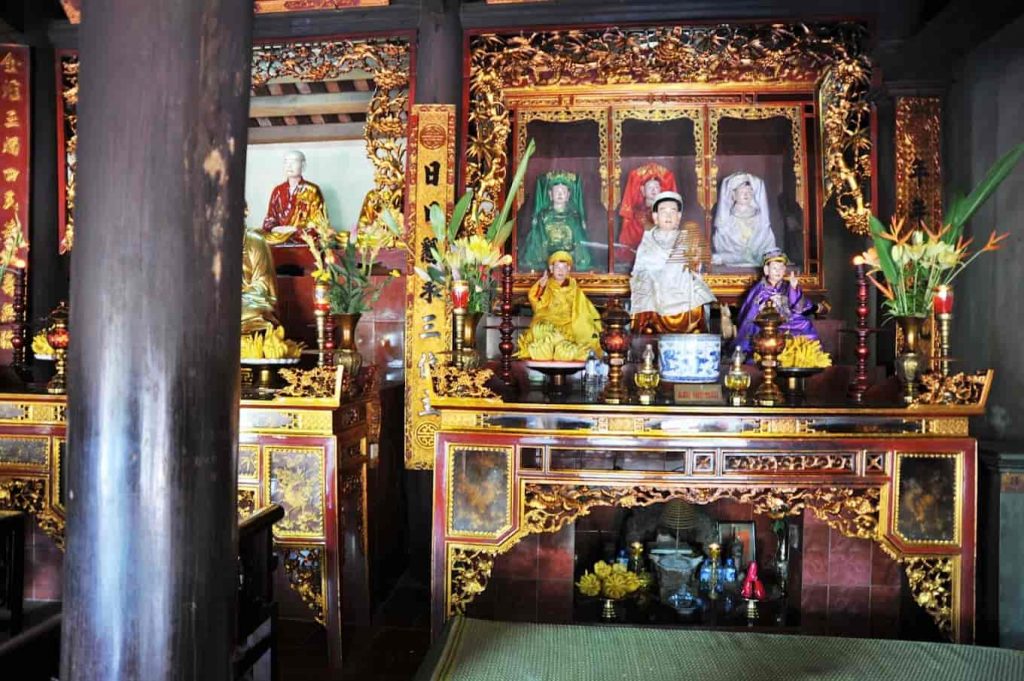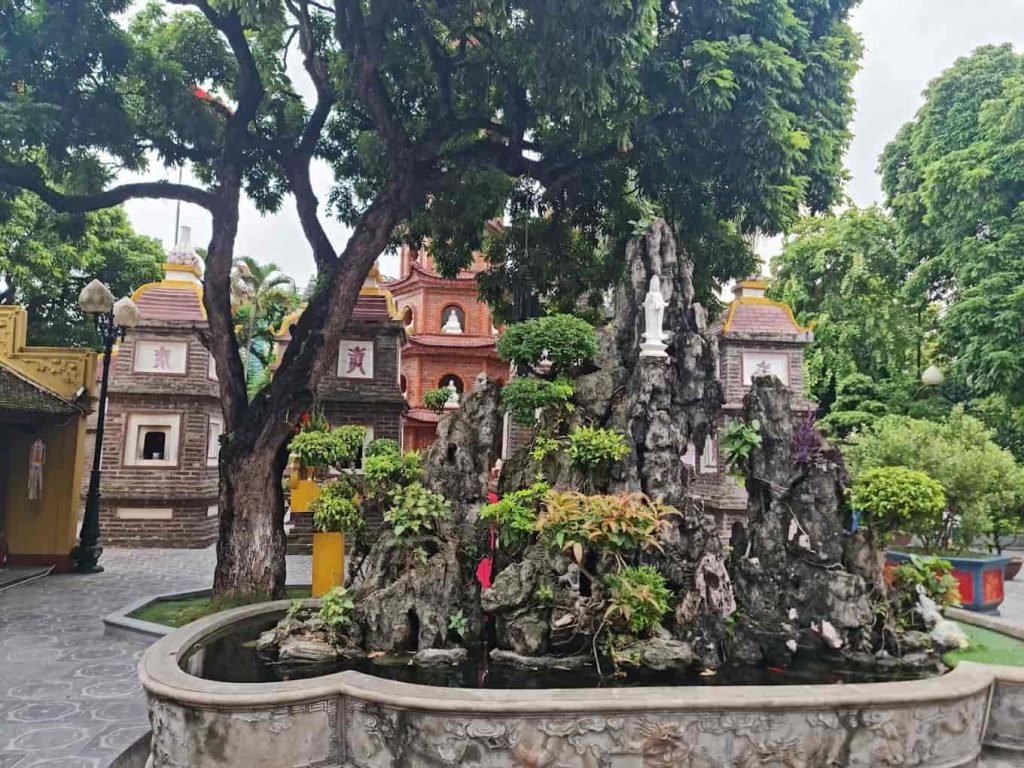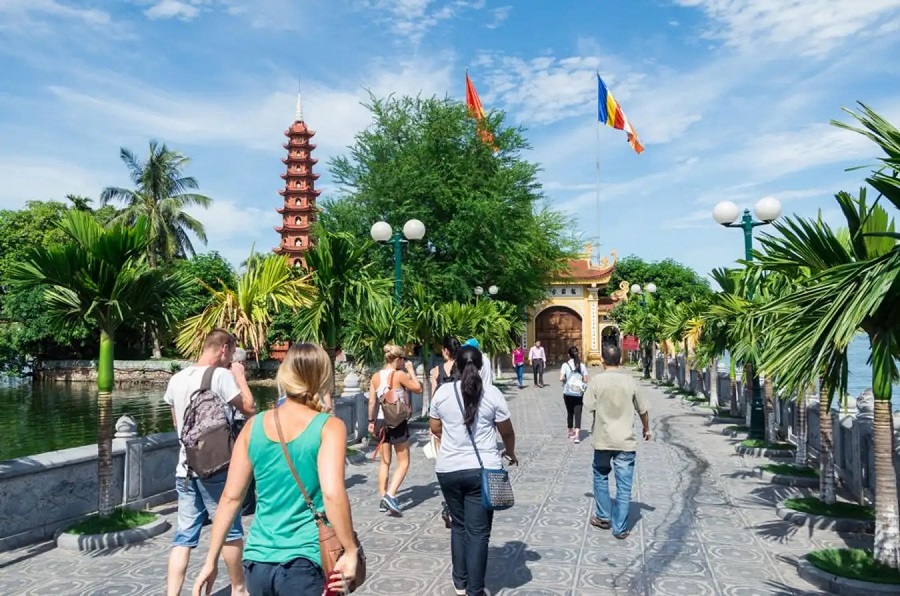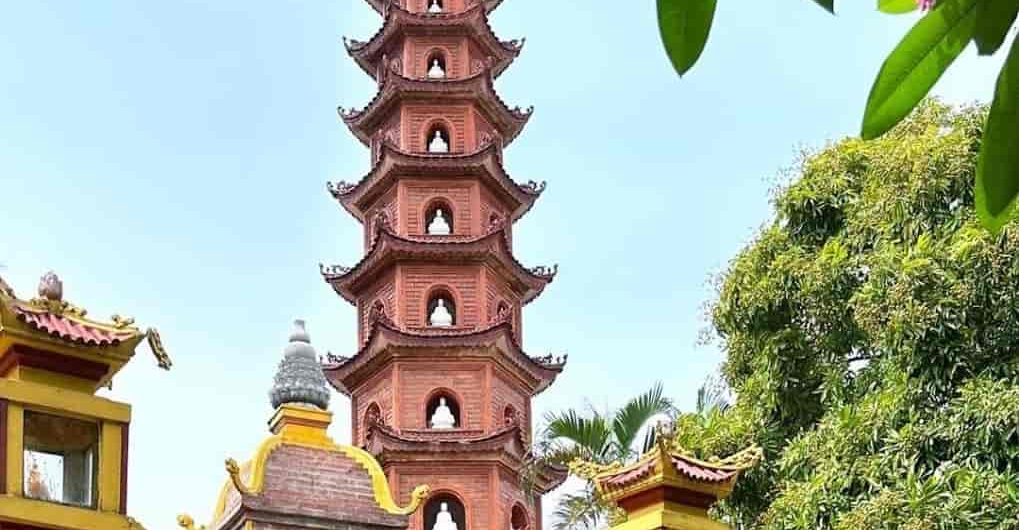Tran Quoc Pagoda, formerly known as Khai Quoc Pagoda or Tran Quoc Ancient Pagoda, was built with the purpose of praying for the nation’s prosperity and people’s well-being. It is not only a spiritual and cultural tourist attraction for international visitors but also holds great significance for the people of Hanoi. On occasions such as the 1st and 15th day of the lunar month or the beginning of the new year, the people of Hanoi come here to offer incense, pray for their wishes to come true, and seek peace for their families and prosperity for the nation.
Tran Quoc Pagoda in Hanoi is located on the eastern shore of West Lake and is under the management of the Vietnam Buddhist Sangha. The pagoda is open daily from 8 AM to 4 PM for visitors and locals to visit and pay their respects.
Table of Contents
Introduction to Tran Quoc Pagoda.
This is one of the oldest temples in Vietnam, with a history that spans over 1500 years. In the past, the pagoda was the center of Buddhism during the Ly Tran dynasty, and the kings of that era often visited the temple on special occasions for worship and prayer.

Where is Tran Quoc Pagoda located?
The pagoda is situated on an island on the eastern side of West Lake. The specific address is on Thanh Nien Street, Yen Phu Ward, Tay Ho District, Hanoi. It is relatively close to other tourist attractions in Hanoi, such as Bach Thao Park (1km), Quan Thanh Temple (1.1km), Ba Dinh Square (1.5km), the Imperial Citadel of Thang Long (2.3km), and Dong Xuan Market (2.7km).
How to get there?
Visitors can reach the pagoda by bus, motorbike, or taxi. Here are the transportation options:
- Bus: Bus number 50 runs to the pagoda. The bus operates from 5:00 AM to 8:45 PM daily with a frequency of every 20 minutes, and the fare is 7,000 VND per person per trip. Visitors should disembark at the bus stop on Thanh Nien Street and then walk to the pagoda’s entrance.
- Motorbike: For those who have motorbikes, it takes about 20 minutes to ride from the city center to the pagoda. You can park your motorbike in the parking area opposite Tran Quoc Pagoda, near Tay Ho ice cream shop. The parking fee ranges from 5,000 to 10,000 VND per motorbike per trip.
- Private Car with Driver: If you prefer a convenient and hassle-free option, you can use a private car with a driver service in Hanoi, such as DanangPrivateCar.com’s. They will pick you up from anywhere in Hanoi and take you to Tran Quoc Pagoda quickly. You can also explore other attractions in Hanoi using their service at publicly listed prices on their website, without any additional costs.
- Taxi or Grab: Some Hanoi taxi companies include Taxi Mai Linh (024 38 333333), Taxi Group (024 38 26 26 26), and Taxi Thanh Nga (024 38 215 215).
Who is worshiped at Tran Quoc Pagoda?
The pagoda is a place of worship for Buddhists and is under the management of the Vietnam Buddhist Sangha.
In the past, it was visited by kings and queens for prayer and discussions. For example, during the reign of King Le Nhan Tong, Queen Y Lan often came here for discussions. The pagoda was also visited by King Minh Mang and King Thieu Tri, who granted funds for its renovation.

What do people pray for when visiting Tran Quoc Pagoda?
When visiting the pagoda, people often pray for peace and happiness for their families, as well as for wealth, prosperity, and success in their careers. It is suggested that preparing a prayer text in advance will make it easier for you to pray when you visit.
The worship process typically involves making offerings at the Altar of Ancestors (usually with savory offerings), followed by the Triple Gem Altar (vegetarian offerings), and finally at the Ancestors’ House.
Tran Quoc Pagoda has also had the honor of being visited twice by the President of India and once by the President of Russia during their official visits to Vietnam.
Regulations
Guidelines for Visiting the Pagoda:
- As this is a place of worship, visitors should dress neatly and avoid wearing revealing clothing, sleeveless shirts, shorts, or short skirts.
- When visiting the pagoda, visitors should keep their voices low and avoid making loud noises that could disrupt the solemn atmosphere of the sacred place.
- Visitors are encouraged to dispose of their litter in designated bins and refrain from littering in or around the pagoda.
Opening Hours and Admission Fees at Tran Quoc Pagoda.
Tran Quoc Pagoda welcomes visitors for sightseeing and worship from 8:00 AM to 4:00 PM daily. On the 1st and 15th days of each lunar month, the pagoda extends its opening hours from 6:00 AM to 6:00 PM, and on the New Year’s Eve of the Lunar New Year, the pagoda remains open throughout the night.
Tran Quoc Pagoda does not charge an admission fee for both the local residents of Hanoi and tourists. Therefore, you are free to explore, admire the scenery, and pay your respects at the pagoda.
History and Architecture of Tran Quoc Pagoda.
History of Tran Quoc Pagoda in Hanoi.
The pagoda was originally named Khai Quoc Pagoda and was built in 541 during the Early Ly Dynasty. At that time, it was located near the banks of the Red River. However, due to riverbank erosion in 1615 (during the reign of King Le Trung Hung), the pagoda was relocated inland to the Yen Phu embankment area, in the Kim Ngưu land.

Subsequently, in the 17th century, under the rule of the Trinh lords, the Co Ngự dyke (now known as Thanh Nien Street) was constructed to connect with the Kim Ngưu island. The pagoda was renamed Tran Quoc Pagoda during the reign of King Le Hy Tong (1681 – 1705) with the intention of making it a place where people could ward off natural disasters and bring peace to the nation. This name has been retained to this day.
In history, this pagoda was the Buddhist center of Thang Long Imperial City. Kings of the Ly and Tran dynasties often visited and made offerings on various ceremonial occasions and festivals at the pagoda.
If you’re looking for airport transfer services from Noi Bai Airport to the center of Hanoi, book a private car service from DanangPrivateCar.com today to schedule your itinerary.
Architecture of Tran Quoc Pagoda in Hanoi.
Explore the Architecture of Tran Quoc Pagoda.
The images of Tran Quoc Pagoda clearly exhibit Eastern architectural elements, combined with the natural landscape, following the strict principles and order of Buddhism. After numerous renovations and repairs, Tran Quoc Pagoda now covers an area of over 3,000 square meters, consisting of three main structures: the Main Hall, the Upper Hall, and the Front Hall, interconnected in a C-shape.

The Front Hall faces west and is located in the middle of the pagoda complex. On both sides are the Main Hall and the Upper Hall, connected by two extended corridors. Behind these halls is a three-bay building with overlapping curved roofs, followed by a bell tower located on the main hall’s axis. On the left is a stone stele house that houses 14 steles with significant cultural and historical value, while on the right is the ancestral hall. In the 18th century, during the reign of King Le Y Tong, numerous additional towers were constructed behind Tran Quoc Pagoda.
In 1998, the Chief Abbot of Tran Quoc Pagoda, Venerable Kim Cuong Tu, had the Lotus Tower built prominently in the ancient tower garden. The Lotus Tower is symmetrical to the Bodhi tree, a gift from Indian President Rajendra Prasad during his visit in 1959. With its immense historical value and unique architecture, Tran Quoc Pagoda was recognized as a National Cultural and Historical Relic in 1989.
Offering Incense and Praying for Peace.
Tran Quoc Pagoda is a sacred place for people to seek luck and peace. Visiting Tran Quoc Pagoda has long been a tradition for Hanoi residents on occasions like Tet (Lunar New Year) and the 1st and 15th days of each lunar month. Whether you’re visiting for sightseeing or for worship, it’s customary to bring incense, offerings, and carefully prepared prayers to the various altars in the pagoda as a sign of respect. Some common prayers at the pagoda include prayers for peace and offerings to the ancestors.

Admire the Bodhi Tree of Tran Quoc Pagoda.
Whenever Tran Quoc Pagoda is mentioned, people inevitably think of the large Bodhi tree, derived from the original Bodhi tree at Bodh Gaya, where Gautama Buddha attained enlightenment 25 centuries ago. The Bodhi tree at Tran Quoc Pagoda holds deep spiritual significance, symbolizing compassion and generosity towards humanity and representing the wisdom of the Buddha. Every year, many visitors come to Tran Quoc Pagoda to pay their respects, make pilgrimages, and offer prayers to the Bodhi tree.

Over nearly 60 years since it was gifted by Mr. Prasat, the Bodhi tree has been meticulously cared for by the resident monks, and it remains as vibrant and vital as ever. The shade of the Bodhi tree creates a picturesque, tranquil setting, and the air is exceptionally pure and refreshing.
Admire the Unique Beauty of Buddha and Bodhisattva Statues.
Visitors can admire the unique beauty of various Buddha and Bodhisattva statues in the Lotus Tower and the Front Hall of Tran Quoc Pagoda. The Lotus Tower, standing 11 stories tall with an area of approximately 10.5 square meters, houses a precious jade Buddha statue. Inside the tower, there are also around 66 other statues. At the top of the tower is a nine-story lotus tower, resembling a blooming lotus flower emitting a fragrant scent, made from sparkling precious stones.

After visiting the Lotus Tower, visitors can proceed to pay their respects to Buddha and make offerings at the Front Hall. Here, you’ll find various statues of Buddha, with the most prominent being the statue of Shakyamuni Buddha, coated in gold leaf. Other Buddha statues are cast in shining bronze.
Famous Tourist Destinations near Tran Quoc Pagoda.
To enhance your travel experience in Hanoi, consider combining a visit to Tran Quoc Pagoda with nearby recreational spots. Here is a list of famous attractions near the pagoda that you can explore:
Quan Thanh Temple.
For a spiritual journey in Hanoi, you must not miss Quan Thanh Temple, one of the “four temples” of the Thang Long Imperial City. Despite the passage of time and various historical dynasties, Quan Thanh Temple has preserved its cultural beauty and unique architecture, adding to the city’s ancient charm.
Thang Long Imperial Citadel.
Closely tied to the development of ancient Thang Long (now Hanoi), the Thang Long Imperial Citadel is one of the most captivating heritage sites that attracts a large number of tourists. In the historical relics system of Vietnam, Thang Long Imperial Citadel plays a pivotal role. Visitors to this site can explore prominent structures like the Đoan Môn (Main Gate), Bắc Môn (North Gate), Điện Kính Thiên (Kinh Thien Palace), and the archaeological site.
Ho Chi Minh Mausoleum.
A visit to the Ho Chi Minh Mausoleum is a must when traveling in Hanoi. This is where the beloved leader of the nation, Ho Chi Minh, rests. The area around the mausoleum is adorned with lush bamboo groves, creating a tranquil and serene atmosphere. The Ho Chi Minh Mausoleum is open to visitors on Tuesday, Wednesday, Thursday, Saturday, and Sunday mornings. In addition to paying respects, visitors can witness the flag-raising and lowering ceremonies during specified hours. A small reminder when visiting the Ho Chi Minh Mausoleum is to dress modestly and refrain from bringing electronic recording devices.
Hanoi Old Quarter.
Exploring the Old Quarter and admiring the ancient houses while savoring local specialties is an experience you shouldn’t miss when visiting Hanoi. Hanoi’s Old Quarter is located in the northern and western parts of Hoan Kiem Lake. Each street specializes in selling specific goods, and you can stroll around for shopping, photography, and more. Additionally, you should take the time to savor the culinary delights of the Old Quarter, such as Cha Ca La Vong (grilled fish), Bun Rieu Cua (crab noodle soup), and Pho Bat Dan (noodle soup).
Tay Ho Palace.
Tay Ho Palace, also known as the Liễu Hạnh Princess Temple, is one of the famous spiritual tourist destinations in the capital. It boasts unique architecture, with intricate details reflecting Vietnamese culture. Many people visit Tay Ho Palace to admire the scenery, take photos, and seek health, fortune, and success.
Through the ups and downs of Hanoi’s history, Tran Quoc Pagoda still stands proudly, exuding a majestic and solemn beauty unique to the people of Hanoi. It is also a venue for important religious activities of the Buddhist community and is revered by the locals as the “Sacred Pagoda in Hanoi.“


Comments